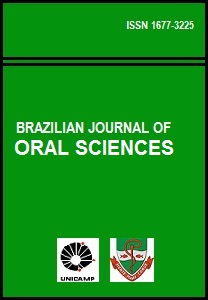Abstract
Aim: The aim of this in vitro study was to investigate the synergistic effect of chemical degradation (erosion) and three-body abrasion (mechanical degradation) on the surface roughness (Ra) and hardness (KHN) of two nanorestorative materials and two conventional materials. Methods: Discshaped specimens (5 mm in diameter, 2 mm thick) of Filtek Z350TM and TPH SpectrumTM composites and Ketac NanoTM and VitremerTM light-curing glass ionomer cements, nanomaterials and conventional materials were prepared according to the manufacturer’s instructions. After 24 h, polishing procedures were performed and initial measurements of Ra and KHN were taken in all specimens. The specimens were divided into 12 groups (n = 10) according to material and storage media: artificial saliva, orange juice, and Coca-Cola®. After 30 days of storage, the specimens were submitted to mechanical degradation and re-evaluated for Ra and KHN. Data were tested for significant differences by repeated-measure three-way ANOVA and Tukey’s tests (p<0.05). Results: Erosion and abrasion wear significantly decreased hardness of all materials. Only Filtek Z350 roughness, however, was not affected by erosion and abrasion. All materials showed a significant increase in surface roughness after erosion and abrasion, except for Filtek Z350. After chemical and mechanical degradation, the KHN of all samples had decreased significantly. After mechanical degradation, the acidic drinks (Coca-Cola® and orange juice) were more aggressive than artificial saliva to all materials. Conclusions: A synergistic effect was observed by the increase in roughness for all materials, except for Filtek Z350; hardness values decrease for all materials, regardless of whether they were nanofilled or not. The RMGICs were more susceptible to degradation than the composites, considering both hardness and roughness surface parameters.References
Schmidt C, Ilie N. The effect of aging on the mechanical properties of nanohybrid composites based on new monomer formulations. Clin Oral Investig. 2013; 17: 251-7.
Senawongse P, Pongprueksa P. Surface roughness of nanofill and nanohybrid resin composites after polishing and brushing. J Esthet Restor Dent. 2007; 19: 265-73.
de Paula AB, Fucio SB, Ambrosano GM, Alonso RC, Sardi JC, PuppinRontani RM. Biodegradation and abrasive wear of nano restorative materials. Oper Dent. 2011; 36: 670-7.
Asmussen E. Softening of Bis-GMA-based polymers by ethanol and by organic acids of plaque. Scand J Dent Res. 1984; 92: 257-61.
Edwards M, Creanor SL, Foye RH, Gilmour WH. Buffering capacities of soft drinks: the potential influence on dental erosion. J Oral Rehabil. 1999; 26: 923-7.
Jensdottir T, Arnadottir IB, Thorsdottir I, Bardow A, Gudmundsson K, Theodors A, et al. Relationship between dental erosion, soft drink consumption, and gastroesophageal reflux among Icelanders. Clin Oral Investig. 2004; 8: 91-6.
Jensdottir T, Bardow A, Holbrook P. Properties and modification of soft drinks in relation to their erosive potential in vitro. J Dent. 2005; 33: 569-75.
Francisconi LF, Honório HM, Rios D, Magalhães AC, Machado MA, Buzalaf MA. Effect of erosive pH cycling on different restorative materials and on enamel restored with these materials. Oper Dent. 2008; 33: 203-8.
Lopes MB, Saquy PC, Moura SK, Wang L, Graciano FM, Correr Sobrinho L, et al. Effect of different surface penetrating sealants on the roughness of a nanofiller composite resin. Braz Dent J. 2012; 23: 692-7.
Carvalho FG, Sampaio CS, Fucio SB, Carlo HL, Correr-Sobrinho L, Puppin-Rontani RM. Effect of chemical and mechanical degradation on surface roughness of three glass ionomers and a nanofilled resin composite. Oper Dent. 2012; 37: 509-17.
Seow LL, Chong SY, Lau MN, Tiong SG, Yew CC. Effect of beverages and food source on wear resistance of composite resins. Malaysian Dent J. 2008; 29: 34-9.
Addy M, Hunter ML. Can tooth brushing damage your health? Effects on oral and dental tissues. Int Dent J. 2003; 53: 177-86.
de Fúcio SB, de Paula AB, de Carvalho FG, Feitosa VP, Ambrosano GM, Puppin-Rontani RM. Biomechanical degradation of the nano-filled resin-modified glass-ionomer surface. Am J Dent. 2012; 25: 315-20.
Gladys S, Van Meerbeek B, Braem M, Lambrechts P, Vanherle G. Comparative physico-mechanical characterization of new hybrid restorative materials with conventional glass-ionomer and resin composite restorative materials. J Dent Res. 1997; 76: 883-94.
Cavalcante LM, Masouras K, Watts DC, Pimenta LA, Silikas N. Effect of nanofillers’ size on surface properties after toothbrush abrasion. Am J Dent. 2009; 22: 60-4.
Yap AU, Low JS, Ong LF. Effect of food-simulating liquids on surfasse characteristics of composite and polyacid-modified composite restoratives. Oper Dent. 2000; 25: 170-6.
Wu W, McKinney JE. Influence of chemicals on wear of dental composites. J Dent Res. 1982; 61: 1180-3.
Barbour ME, Shellis RP. An investigation using atomic force microscopy nanoindentation of dental enamel demineralization as a function of undissociated acid concentration and differential buffer capacity. Phys Med Biol. 2007; 52: 899-910.
Turssi CP, Ferracane JL, Vogel K. Filler features and their effects on wear and degree of conversion of particulate dental resin composites. Biomaterials. 2005; 26: 4932-7.
Cilli R, Pereira JC, Prakki A. Properties of dental resins submitted to pH catalysed hydrolysis. J Dent. 2012; 40: 1144-50.
Sarkar NK. Internal corrosion in dental composite wear. J Biomed Mater Res. 2000; 53: 371-80.
Ferracane JL. Hygroscopic and hydrolytic effects in dental polymer networks. Dent Mater. 2006; 22: 211-22.
Mohan M, Shey Z, Vaidyanathan I, Vaidyanathan TK, Munisamy S, Janal M. Color changes of restorative materials exposed in vitro to cola beverage. Pediatr Dent. 2008; 30: 309-316.
Turssi CP, Hara AT, Serra MC, Rodrigues AL Jr. Effect of storage media upon the surface micromorphology of resin-based restorative materials. J Oral Rehabil. 2002; 29: 864-71.
Condon JR, Ferracane JL. In vitro wear of composite whit varied cure, filler level, and filler treatment. J Dent Res. 1997; 76: 1405-11.

This work is licensed under a Creative Commons Attribution 4.0 International License.
Copyright (c) 2015 Andréia Bolzan de Paula, Roberta Caroline Bruschi Alonso, Giovana Albamonte Spagnolo de Araújo, Julia Puppin Rontani, Lourenço Correr-Sobrinho, Regina Maria Puppin-Rontani

